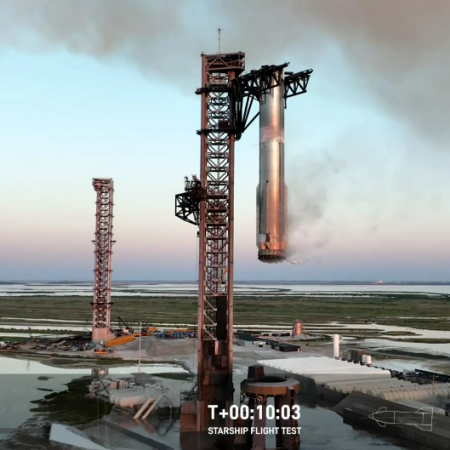Oh no! Starship/Superheavy is loud!

Superheavy after its October flight, safely captured at Boca Chica
Time for another Chicken Little report: A new study of the sound levels produced by SpaceX’s Superheavy booster during its fifth launch and landing at Boca Chica in October 2024 suggests that it produces more noise than predicted.
Overall … Gee et al. note that one of the most important conclusions from their data is the differences between Starship’s launch noise levels and those of SLS and Falcon 9. The team found that Starship produces significantly more noise at liftoff than both SLS and Falcon 9 in both A-weighted and Z-weighted (unweighted) noise metrics.
When compared to Falcon 9, the noise produced by a single Starship launch is equivalent to, at a minimum, 10 Falcon 9 launches. Despite SLS producing more than half of Starship’s overall thrust at liftoff, Starship is substantially louder than SLS. More specifically, one Starship launch is equivalent to that of four to six SLS launches regarding noise production. As has been hypothesized by numerous other studies into the noise produced by rockets, this significant difference in noise levels may be due to the configuration of first-stage engines on the rockets. For example, although the Saturn V produced less overall thrust than SLS, it produced two decibels more noise than SLS, which may be due to the clustered engine configuration on Saturn V’s first stage.
We’re all gonna die! Despite the doom-mongering of this study (which you can read here), the only issue noted by the paper from this noise was car alarms going off. And even here, the spread of the noise was asymmetrical, occurring in only one direction.
The concern about sonic booms has always been the annoyance they cause to residents near airports. In the case of Superheavy, it is very unlikely it will ever fly at a frequency to make its noise intolerable. More important, the nature of a spaceport versus an airport reduces the concern considerably, since a spaceport requires a much larger buffer area, and at both of SpaceX’s Starship launchsites in Florida and Texas almost everyone living close by works for the company or in the space business. They are not going to complain.
And while studying these noise issues is useful, we must not be naive about the real purpose of such studies. Underneath its high-minded science goals is a much more insidious one: finding a weapon for shutting down SpaceX. This concern of mine might be overstated, but remember, almost our entire academic community is rabidly leftist and made up of partisan Democrats. They hate Musk for his politics, and have been aggressively looking for ways to hurt him. This sound study is just another tool in that war.

Superheavy after its October flight, safely captured at Boca Chica
Time for another Chicken Little report: A new study of the sound levels produced by SpaceX’s Superheavy booster during its fifth launch and landing at Boca Chica in October 2024 suggests that it produces more noise than predicted.
Overall … Gee et al. note that one of the most important conclusions from their data is the differences between Starship’s launch noise levels and those of SLS and Falcon 9. The team found that Starship produces significantly more noise at liftoff than both SLS and Falcon 9 in both A-weighted and Z-weighted (unweighted) noise metrics.
When compared to Falcon 9, the noise produced by a single Starship launch is equivalent to, at a minimum, 10 Falcon 9 launches. Despite SLS producing more than half of Starship’s overall thrust at liftoff, Starship is substantially louder than SLS. More specifically, one Starship launch is equivalent to that of four to six SLS launches regarding noise production. As has been hypothesized by numerous other studies into the noise produced by rockets, this significant difference in noise levels may be due to the configuration of first-stage engines on the rockets. For example, although the Saturn V produced less overall thrust than SLS, it produced two decibels more noise than SLS, which may be due to the clustered engine configuration on Saturn V’s first stage.
We’re all gonna die! Despite the doom-mongering of this study (which you can read here), the only issue noted by the paper from this noise was car alarms going off. And even here, the spread of the noise was asymmetrical, occurring in only one direction.
The concern about sonic booms has always been the annoyance they cause to residents near airports. In the case of Superheavy, it is very unlikely it will ever fly at a frequency to make its noise intolerable. More important, the nature of a spaceport versus an airport reduces the concern considerably, since a spaceport requires a much larger buffer area, and at both of SpaceX’s Starship launchsites in Florida and Texas almost everyone living close by works for the company or in the space business. They are not going to complain.
And while studying these noise issues is useful, we must not be naive about the real purpose of such studies. Underneath its high-minded science goals is a much more insidious one: finding a weapon for shutting down SpaceX. This concern of mine might be overstated, but remember, almost our entire academic community is rabidly leftist and made up of partisan Democrats. They hate Musk for his politics, and have been aggressively looking for ways to hurt him. This sound study is just another tool in that war.


